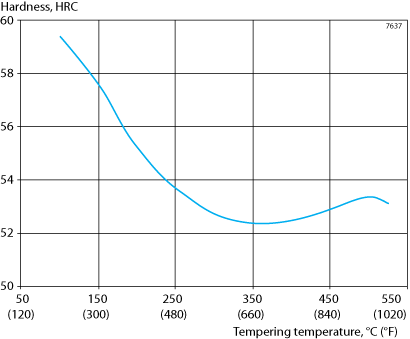Alleima® 12C27M is a martensitic stainless chromium steel developed for the manufacture of kitchen tools with high demands on wear- and corrosion resistance properties. After heat treatment the grade is characterized by:
- High hardness which gives good wear resistance.
- Good corrosion resistance
Typical applications for Alleima® 12C27M are kitchen tools, such as different types of knives and scissors, that need to tolerate dish-washing.
Standards
- ASTM: (420, 440A)
- W.Nr.: (1.4034/1.4037)
In brackets, nearest corresponding grade.
Chemical composition (nominal)
| C | Si | Mn | P | S | Cr |
|---|---|---|---|---|---|
| 0.52 | 0.4 | 0.6 | ≤0.025 | ≤0.010 | 14.5 |
Forms of supply
The material can be supplied either in coils or as straightened lengths of 0.5–4.0 meter (20 - 157 in.). The maximum coil weight is 5 kg/mm (280 lbs/in.) of the strip width.
Hardening and tempering of the strip steel is needed to achieve the correct finish and to meet the properties required by the end user.
| Thickness | Width | ||
|---|---|---|---|
| mm (in.) | mm (in.) | ||
| Min. | Max. | Min. | Max. |
| 1.0 (0.039) | 4.5 (0.177) | 10 (0.394) | 380 (14.96) |
Other sizes can be supplied to meet specific requirements.
Tolerances
The thickness and width tolerances are +/- tolerances to the nominal size. The normal tolerance classes for most of our strip products are T2 and B1. Tighter tolerances as well as other tolerance limits can be offered upon request.
| As-delivered | Tensile strength | Hardness* | HRB |
|---|---|---|---|
| MPa (ksi) | HV | ||
| Soft annealed |
max. 700 (102)
|
max. 215 | max. 94.3 |
| Annealed |
750 ±100 (109±14)
|
235 ±35 | 97.4 ±6 |
| Cold rolled |
700–1000 (102–145)
|
215–315 | 94.3–106.6 |
* Hardness data is for guidance only.
Heat treatment
Hardening data
Hardening temperature 1080°C (1975°F), strip thickness 2.5 mm (0,098 in.), holding time 5 minutes, quenching in oil.
Tempering data
Tempering time 30 minutes.

Brittleness occurs with tempering above 450°C (840°F).
Additional recommendations regarding hardening can be found in Alleima's hardening guide.
The following figures show the importance of using the right hardening conditions to optimize the microstructure and properties.
 Too high hardening temperature gives coarse structure, high austenite content (30%), few carbides. Consequence: low hardness and bad wear resistance.
Too high hardening temperature gives coarse structure, high austenite content (30%), few carbides. Consequence: low hardness and bad wear resistance.
 Too low cooling rate after austenitizing gives carbide precipitations in the grain boundaries. Consequence: brittleness and reduced corrosion resistance.
Too low cooling rate after austenitizing gives carbide precipitations in the grain boundaries. Consequence: brittleness and reduced corrosion resistance.
 Optimized hardening conditions give optimal austenite content (15%), many uniformly distributed carbides. Consequence: optimal combination of hardness, wear resistance, ductility and corrosion resistance.
Optimized hardening conditions give optimal austenite content (15%), many uniformly distributed carbides. Consequence: optimal combination of hardness, wear resistance, ductility and corrosion resistance.
How the hardening parameters affect the product properties
- Too high hardening temperature gives low hardness and bad wear resistance due to excessive content of retained austenite.
- A low hardening temperature gives low hardness and reduced corrosion resistance.
- Too long holding time at the optimal hardening temperature increases the amount of retained austenite and lowers the hardness.
- Too short holding time at the optimal hardening temperature has the same effect as low austenitizing temperature.
- The maximum hardness will be obtained at a retained austenite content of about 15%.
- Deep freezing, i.e. cooling to below room temperature, increases the hardness by about 1–2 HRC.
- With deep freezing, the highest possible hardness will be achieved by increasing the hardening temperature. Read more in the Alleima hardening guide.
- High cooling rate after hardening is necessary to avoid brittleness and reduced corrosion resistance. 600°C (1112°F) should be reached within 1–2 minutes and room temperature within 30 minutes.
- Rehardening is generally not recommended as it will not give optimal product properties.
Physical properties
The physical properties of a steel are related to a number of factors, including alloying elements, heat treatment and manufacturing route, but the data presented below can generally be used for rough calculations.
| Density | |
|---|---|
| g/cm3 | 7.8 |
| lb/in.3 | 0.28 |
Disclaimer: Recommendations are for guidance only, and the suitability of a material for a specific application can be confirmed only when we know the actual service conditions. Continuous development may necessitate changes in technical data without notice. This datasheet is only valid for Alleima materials.